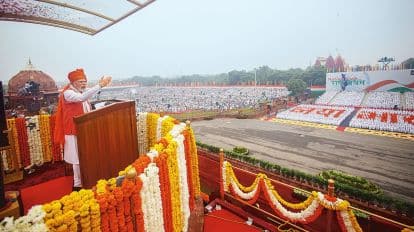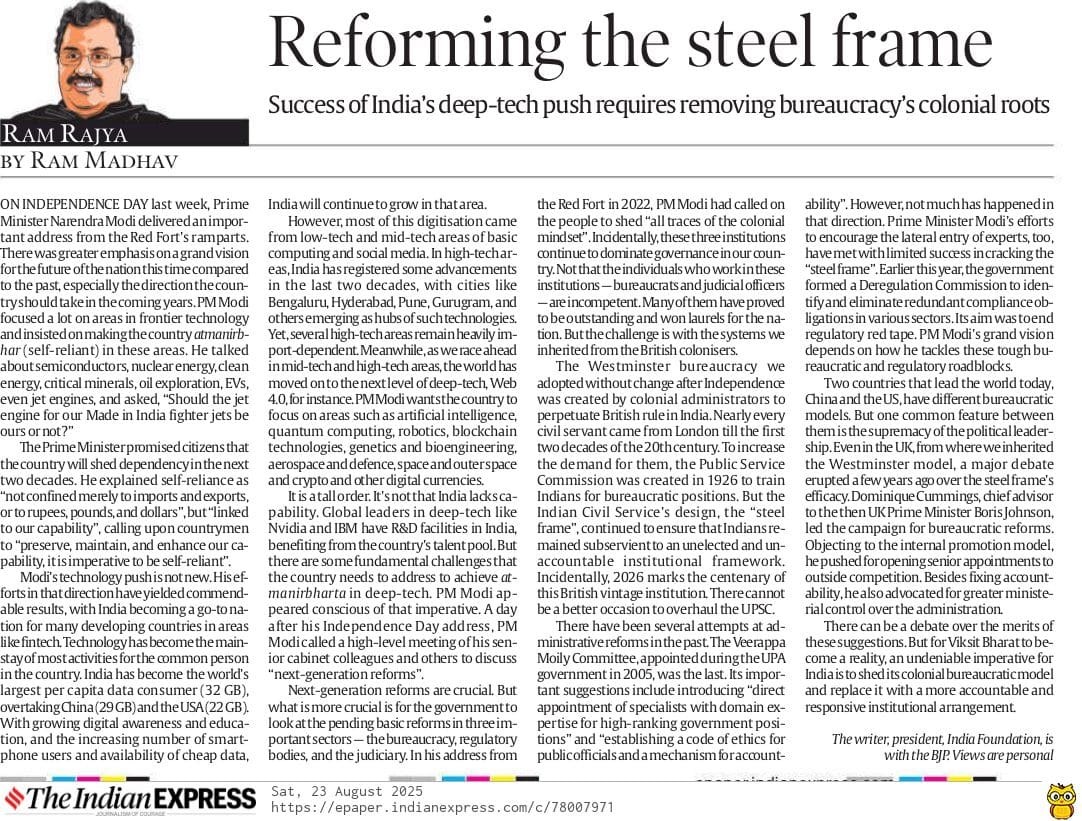
|
Getting your Trinity Audio player ready...
|
(The article was originally published in Indian Express on August 23, 2025 as a part of Dr Madhav’s column titled ‘Ram Rajya’. Views expressed are personal.)
On this Independence Day, Prime Minister Narendra Modi delivered an important address from the Red Fort ramparts. Unlike in the past, there was a greater emphasis on the grand vision for the future of the nation with a specific direction to it this time. Prime minister focused a lot on areas of frontier technology and insisted on making the country Atmanirbhar – self-reliant in all those areas. He talked about semiconductors, nuclear energy, clean energy, critical minerals, oil exploration, EVs and even jet engines, pointedly asking, “should the jet engine for our Made in India fighter jets be ours or not?”
Modi promised to the citizens that the country will shed its dependency in the next two decades and become truly self-reliant. He explained self-reliance as “not confined merely to imports and exports, or to rupees, pounds, and dollars”, but “linked to our capability”, calling upon the countrymen to “preserve, maintain, and enhance our capability, it is imperative to be self-reliant”.
Modi’s technology push is not new. His efforts in that direction yielded commendable results with India becoming a go-to nation for many developing countries in areas like fin-tech. Within the country too, technology became the mainstay of most activities for the common man. Digital economy grew manifold making the country the world’s largest per capita data consumer (32 GB) overtaking China (29 GB) and the USA (22 GB). With growing digital awareness and education, and also with the growing number of smartphone users and availability of cheap data, India will continue to grow in that area for many years to come.
However, most of this digitisation came from low-tech and mid-tech areas of basic computing and social media. In the high-tech areas, India did register some advancements in the last couple of decades with cities like Bengaluru, Hyderabad, Pune, Gurugram and others emerging as high-tech hubs. Yet, several high-tech areas remain heavily import-dependent. Meanwhile, as we race ahead in mid-tech and high-tech areas, the world moved on to the next higher level of deep-tech areas of 4th generation internet, or Web 4.0. Prime minister Modi wants the country to focus now on these deep-tech areas that include artificial intelligence, quantum computing, robotics, blockchain technologies, genetics and bioengineering, aerospace and defence, space and outer space and crypto and other digital currencies.
It is a tall order. Nobody says that India lacks capability. In fact, many global leaders in deep-tech like Nvidia and IBM have their R&D facilities in India too, benefitting from the talent pool available here. But there are some fundamental challenges that the country needs to address in order for it to achiev Atmanirbharta in deep-tech. Prime minister appeared conscious of that imperative. A day after his futuristic address from the Red Fort, prime minister huddled into a high-level meeting of his senior cabinet colleagues and others to discuss about “next generation reforms”.
Next generation reforms are crucial. But ahead of them, more crucial is for the government to look at another pending area of basic reforms in three important sectors – bureaucracy, regulatory bodies and judiciary. It may be recalled that in his address from the Red Fort in 2022, prime minister Modi called upon the countrymen to shed “all traces of colonial mind-set”. Incidentally, these three institutions continue to function as the important colonial relics dominating governance in our country. Not that the individuals manning these institutions – bureaucrats and judicial officers – are bad. Many of them proved to be outstanding and won the laurels of the entire nation. But the challenge is with the systems that we inherited from the British colonisers.
The Westminster bureaucracy that we adopted without change after Independence is a mid-19th century appendage created by the British Governor Generals like Warren Hastings and Cornwallis. It was created essentially to perpetuate the British rule in our country. While until early 1900s, the civil servants came from London, in view of the increasing demand for them in greater numbers, the Union Public Service Commission was created in 1926 to train Indians also into bureaucratic positions. The Indian Civil service – ICS – was created and soon acquired both fame and notoriety as the “steel frame”. It was designed in such a way to ensure that Indians remained subservient to an unelected and unaccountable institutional framework. Incidentally, 2026 marks the centenary of this British vintage institution. There cannot be a better occasion for its overhaul than that.
There have been several attempts at reforms in the past. The Veerappa Moily Committee, appointed during UPA regime in 2005, was the latest. Important suggestions it made include introducing “direct appointment of specialists with domain expertise for high-ranking government positions” and “establishing a code of ethics for public officials and mechanism for accountability”. However, not much has happened in the direction. Prime minister Modi’s efforts to encourage lateral entry of experts too met with limited success in cracking the “iron frame”. Earlier this year, the government formed a Deregulation Commission to identify and eliminate redundant compliance obligations in various sectors. Its aim was to end regulatory red tape. Prime minister’s grand vision for the country’s future depends on how he tackles these toughest bureaucratic and regulatory roadblocks.
Two countries that lead the world today – China and the US – have different bureaucratic models. But one common feature between them is the supremacy of the political leadership. Even in the UK, from where we inherited the Westminster model, a major debate erupted a couple of years ago over the efficacy of the steel frame model. Dominique Cummins, chief advisor to prime minister Boris Johnson, led the campaign for bureaucratic reforms. Strongly objecting to the internal promotion model, Cummins pushed for opening senior appointments for outside competition. Besides fixing accountability, he also advocated for greater ministerial control over the administration.
There can be a debate over merits and demerits of these suggestions. But it is an undeniable imperative that for the Viksit Bharat to become a reality, India needs to shed its colonial bureaucratic model in favour of a more accountable and responsive institutional arrangement.




